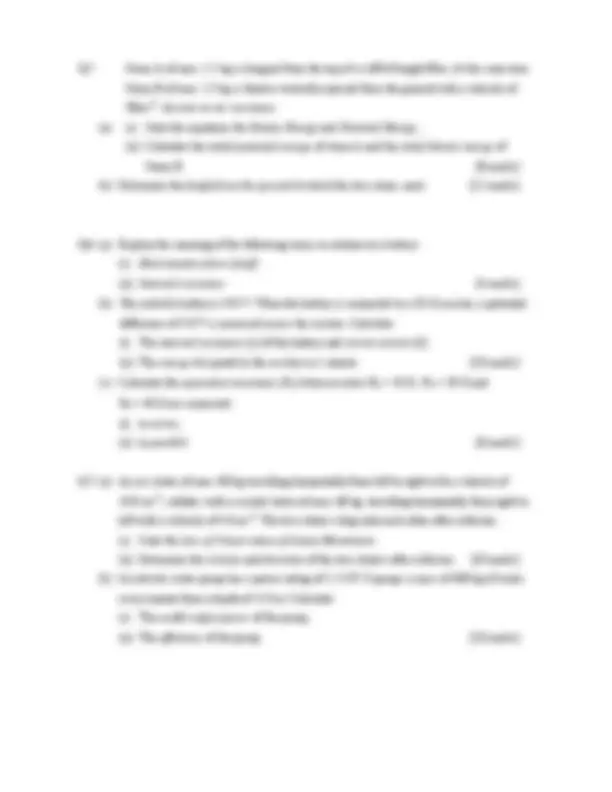



Study with the several resources on Docsity

Earn points by helping other students or get them with a premium plan


Prepare for your exams
Study with the several resources on Docsity

Earn points to download
Earn points by helping other students or get them with a premium plan
Community
Ask the community for help and clear up your study doubts
Discover the best universities in your country according to Docsity users
Free resources
Download our free guides on studying techniques, anxiety management strategies, and thesis advice from Docsity tutors
The questions and answers for a physics exam for students in the bachelor of engineering (honours) in structural engineering program at cork institute of technology. The exam covers topics such as ray diagrams of telescopes, snell's law, newton's third law, and wave motion. Students are required to answer five questions within the given time frame and show all their work for full marks.
Typology: Exams
1 / 3

This page cannot be seen from the preview
Don't miss anything!


(NFQ – Level 8)
Answer FIVE questions only. Show ALL working to gain full marks. Assume: g = 10.0 ms-
Examiners: Mr. T. Corcoran Prof. P. O’Donoghue Dr. M. E. Woods Q1.(a) (i) Sketch a fully-labelled ray diagram of a refracting astronomical telescope operating in normal adjustment incorporating two converging lenses of focal length fo and f (^) e [f (^) o > f (^) e]. Indicate all relevant distances, angles and images. (ii) State the location , magnification , orientation and nature of the final image. (iii) What additional device is incorporated into a terrestrial telescope? How does this device affect the final image? [12 marks] (b) A man outside a swimming pool looks at a coin which he has dropped into the pool which is 3.0 m deep. A ray from the coin to the man has an angle of incidence of 20o^ in the water at the water/air interface. The refractive index of water is 1.33 and the refractive index of air is 1.00. (i) State Snell’s Law and hence calculate the angle of refraction in the air. (ii) Determine the apparent depth of the coin in the pool. [8 marks]
Q2. (a) State Newton’s Third Law. [2 marks]
(b) A block of mass 6.0 kg on a smooth, flat, horizontal table top, is connected by a taut string over a frictionless pulley at the edge of the table, to another block of mass 9.0 kg, which hangs vertically freely. Determine: (i) The acceleration [a] of the blocks. (ii) The tension [T] in the string. [8 marks] (c) A car of mass 1200 kg travels with a steady velocity of 25 ms-1^ along a horizontal road. The frictional force is 6.0 kN. Calculate: (i) The coefficient of dynamic friction between the car and road. (ii) The power of the engine. [10 marks]
Q3. (a) (i) What is meant by the dispersion of light? (ii) Sketch a diagram to show the dispersion of light by a 60 o^ prism. Explain why dispersion occurs. (iii) Name ONE other device , which can generate dispersion of light by a different effect. Name this effect and state ONE difference in the dispersion produced by this device and that generated by a prism. [10 marks] (b) A diffraction grating with 600 lines per millimetre is used to investigate the line spectrum from a Cadmium discharge lamp. The red line was measured to be 644 nm and the green line was measured to be 510 nm. The velocity of light is 3.0 x 10^8 ms -^. (i) Determine the angle of diffraction of the first order red fringe. (ii) Determine the frequency of the green line. [10 marks]
Q4. (a) The displacement y of a progressive water wave travelling horizontally is given by:
The wave has the following properties: frequency = 200 Hz; amplitude = 5.0 cm; wavelength = 0.25 m. (i) Sketch a labelled diagram of displacement versus time for the condition x = 0 m. Determine the period [T] of the wave. Indicate the period and amplitude values on the graph. (ii) Determine the equation for the particle velocity vp. (iii) Calculate the time taken for the displacement to reach a maximum at the position x = 0 cm. [11 marks] (b) A bathysphere has a circular glass window of diameter 6.0 cm. The glass is designed to withstand a pressure of 4.5 MPa. The bathysphere operates in sea water of density 1050 kgm-3^. Determine: (i) The depth at which the glass will shatter. (ii) The force on the glass at this depth. [9 marks]